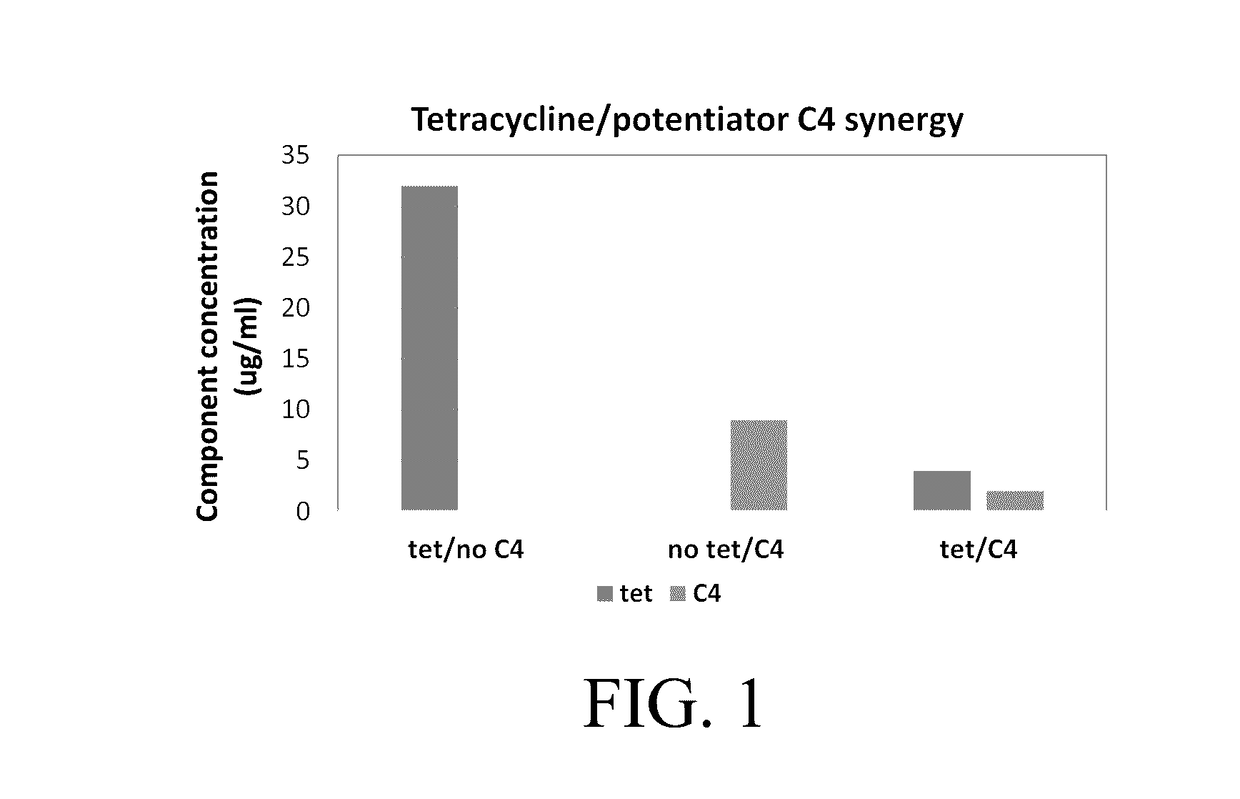Antimicrobial Metal-Binding Polymers
a metal-binding polymer and antimicrobial technology, applied in the field of antimicrobial metal-binding polymers, can solve the problems of neurotoxic concentrations of reserpine necessary to block bacterial efflux, increase in antibiotic resistance observed in human and animal pathogenic microorganisms, and numerous problems in health car
- Summary
- Abstract
- Description
- Claims
- Application Information
AI Technical Summary
Benefits of technology
Problems solved by technology
Method used
Image
Examples
example 1
and Methods
[0026]Synthesis of hyperbranched polyglycerol and linear polyethylene glycol conjugated to citric acid or DTPA. A solution of diethylenetriaminepentaacetic acid (DTPA) in a dry solvent was stirred at 65° C. for 1 hour. The reaction mixture was cooled to room temperature (RT) and then mixed with an appropriate amount of PEG (MW=600) or HPEG, plus N,N-diisopropylethylamine in DMF and allowed to react. The PEG or HPG was dissolved in dioxane at a final concentration of 10 mg / ml and dropped into 5 ml of dimethylsulfoxide (DMSO) containing 143 mg of DTPA anhydride and 24 mg of 4-(dimethylamino)pyridine (DMAP). The reaction solution was magnetically stirred at 40° C. for 6 h, followed by precipitation by diethyl ether. The precipitate was collected by centrifugation (5000 rpm at 20° C. for 10 min), and dissolved in dioxane. This process was repeated 3 times to obtain DTPA-introduced PEG or HPEG. To a mixture of BPEG (420 mg, 0.1 mmol, 1 eq) and DTPA anhydride (714 mg, 2 mmol, 2...
example 2
-PDTC Growth Inhibition Data
[0033]Table 1 shows the checkerboard assay data for berberine-only, berberine and PDTC in an uncomplexed formulation and for the berberine-PDTC complex against two microorganisms: vancomycin-resistant Enterococcus faecalis and methicillin-resistant Staphylococcus aureus. For the berberine-PDTC complex, both compounds are present in equimolar concentrations. The fourth column shows that the berberine-PDTC complex causes a 40 fold and 20 fold reduction in the minimum inhibitory concentration (MIC), respectively, compared to berberine alone.
TABLE 1Berberine and PDTC MIC data.MIC (ug / mL)FoldBerberinePDTCBerberine-PDTCReductionE. faecalis VRE50062.512.540S. aureus MRSA50062.52520
example 3
on Efficacies on Clinical Wound Isolates
[0034]Table 2 shows the inhibitory concentrations for chelator polymers of DTPA (M) and dithiocarbamate (Q) in hospital-acquired clinical wound isolates.
TABLE 2Inhibitory concentrations of different compositions.Number ofClinicalMQBacteriaisolatesisolate(μg / ml)(μg / ml)Acinetobacter56043250100baumannii6175250100627212510068382501006063250100Enterococcus3608012550faecium62466350683112550Pseudomonas55983250100aeruginosa6162125100618625010062951251006311250100Staphylococcus5B-313 12525aureusB-767 25050B-1435812550606112525610825012.5Candida5Y-6359 12512.5albicansY-477 12512.5Y-1298312512.5Y-270221256.25Y-236 12512.5
PUM
| Property | Measurement | Unit |
|---|---|---|
| Density | aaaaa | aaaaa |
| Density | aaaaa | aaaaa |
| Density | aaaaa | aaaaa |
Abstract
Description
Claims
Application Information
 Login to View More
Login to View More - R&D
- Intellectual Property
- Life Sciences
- Materials
- Tech Scout
- Unparalleled Data Quality
- Higher Quality Content
- 60% Fewer Hallucinations
Browse by: Latest US Patents, China's latest patents, Technical Efficacy Thesaurus, Application Domain, Technology Topic, Popular Technical Reports.
© 2025 PatSnap. All rights reserved.Legal|Privacy policy|Modern Slavery Act Transparency Statement|Sitemap|About US| Contact US: help@patsnap.com

